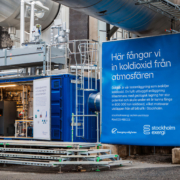Stockholm Exergi
Capture and store carbon dioxide
very significant for the climate
Stockholm Exergi operates a research facility that captures and stores biogenic carbon dioxide at the bio-combined heat and power plant in Hjorthagen in Stockholm. The technology is called bio-CCS and the goal is to have a full-scale facility in place and operational by 2026.
Stockholm Exergi is Stockholm’s energy company. Around the clock, all year round, the burgeoning Stockholm region’s access to heating, cooling, electricity and waste services is now secured. Today, more than 800,000 Stockholmers and more than 400 hospitals, server halls and other businesses are connected to the 3,000 km long district heating network, which connects the heating and cogeneration plants with customers. In Hammarby Sjöstad is the location of Hammarbyverket, which recovers the residual heat from the wastewater that comes to Henriksdal’s treatment plant. The residual heat is transformed into new district heating and this is the way Hammarbyverket contributes to the circular economy.
Developing the circular energy city is the central goal for Stockholm Exergi, which works with laser-like focus on recycling and reducing its carbon dioxide emissions. The goal is for the business to be climate positive as early as 2025. In this way, the company will contribute towards Stockholm’s ambition to become a fossil-free and climate-positive city by 2040. And there is every reason to believe that Stockholm Exergi will succeed. Since 2019, the company has been running a research facility that involves capturing and storing biogenic carbon dioxide at the bio-combined heat and power plant in Hjorthagen in Stockholm. The technology is called bio-CCS and the goal is to have a full-scale facility in place and operational by 2026. It has the potential to capture 800,000 tonnes of carbon dioxide, which corresponds to all the emissions from Stockholm’s car traffic for a whole year. The EU sees the climate potential of the project and has awarded Stockholm Exergi funding from the EU’s Innovation Fund. Capturing and storing carbon dioxide has been identified by the IPCC, the UN’s climate body, as an important contribution to achieving the world’s climate goals.






